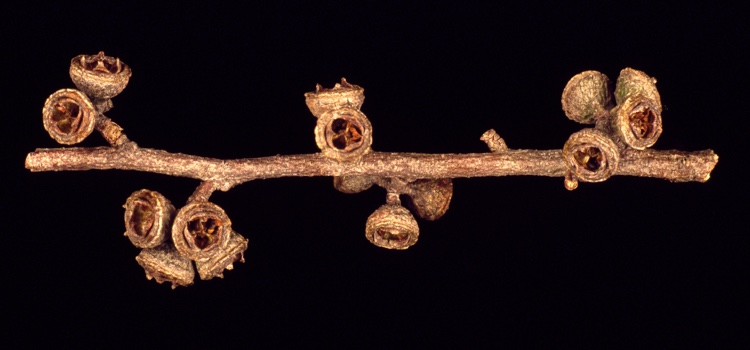Eucalyptus Aggregata on:
[Wikipedia]
[Google]
[Amazon]
''Eucalyptus aggregata'', commonly known as black gum, is a medium-sized tree that is 
endemic
Endemism is the state of a species being found in a single defined geographic location, such as an island, state, nation, country or other defined zone; organisms that are indigenous to a place are not endemic to it if they are also found else ...
to southeastern Australia. It has rough, flaky bark, sometimes smooth on the branches, lance-shaped leaves, green to yellow flower buds in group of seven, white flowers and more or less cup-shaped fruit. It is a component of grassy woodland, often in low-lying or swampy areas, much of which has been cleared and it is under threat.
Description
''Eucalyptus aggregata'' grows as a medium-sized tree, reaching in height, with dark grey to black rough bark that is fibrous and flaky on the trunk and smooth whitish, cream-coloured or greyish bark on the uppermost branches. The leaves on young plants vary but are mostly elliptic to egg-shaped or broadly lance-shaped, long, wide and a slightly lighter shade of green on the lower side. The adult leaves are lance-shaped, alternately arranged along the stems and measure long by wide. They are the same colour on both surfaces. The flower buds are arranged in groups of seven on a peduncle long, the individual buds on apedicel
Pedicle or pedicel may refer to:
Human anatomy
*Pedicle of vertebral arch, the segment between the transverse process and the vertebral body, and is often used as a radiographic marker and entry point in vertebroplasty and kyphoplasty procedures
...
less than long. The buds are oval, green to yellow, long, wide with a cone-shaped or beaked operculum long. The flowers are white and appear from November to May. The fruit is cup-shaped to conical, long, wide.
Taxonomy
''Eucalyptus aggregata'' was first formally described by Henry Deane andJoseph Maiden
Joseph Henry Maiden (25 April 1859 – 16 November 1925) was a botanist who made a major contribution to knowledge of the Australian flora, especially the genus ''Eucalyptus''. This botanist is denoted by the author abbreviation when citing ...
in 1900 from material collected at Wallerawang as the lectotype
In biology, a type is a particular specimen (or in some cases a group of specimens) of an organism to which the scientific name of that organism is formally attached. In other words, a type is an example that serves to anchor or centralizes the ...
. The specific epithet (''aggregata'') is a Latin
Latin (, or , ) is a classical language belonging to the Italic branch of the Indo-European languages. Latin was originally a dialect spoken in the lower Tiber area (then known as Latium) around present-day Rome, but through the power of the ...
word meaning "clustered", referring to the fruit.
Distribution and habitat
Black gum is a rare species found from Capertee and Bathurst in central New South Wales, south through central and southern tablelands, with an isolated population near Woodend in Victoria. It has a very patchy and scattered distribution, as much of the land throughout its range has been cleared for agriculture. ''Eucalyptus aggregata'' grows in woodland and is associated with candlebark (''Eucalyptus rubida
''Eucalyptus rubida'', commonly known as candlebark, ribbon gum or white gum, is a species of small to medium-sized tree that is endemic to south-eastern Australia. It has smooth bark, sometimes with rough bark at the base, lance-shaped or curve ...
''), ribbon gum ('' E. viminalis''), black sally ('' E. stellulata'') broad-leaved peppermint ('' E. dives'') and snow gum ('' E. pauciflora''), with a grassy understory
In forestry and ecology, understory (American English), or understorey (Commonwealth English), also known as underbrush or undergrowth, includes plant life growing beneath the forest canopy without penetrating it to any great extent, but abo ...
of river tussock (''Poa labillardieri
''Poa labillardierei'', also known as common tussock-grass, is a species of tussock grass that is endemic to Australia.
The species was formally described in 1854 by German botanist and physician Ernst Gottlieb von Steudel
Ernst Gottlieb von S ...
'') and silver top wallaby grass ('' Joycea pallida''). The soil is generally poorly drained, alluvial or swampy, with the black gum growing in low-lying areas. These are also natural frost hollows, where cold air persists in the cooler months. It is found at altitudes above , where there are heavy frosts and snow in winter.
Conservation
This species is classed as "vulnerable" under the Australian GovernmentEnvironment Protection and Biodiversity Conservation Act 1999
The ''Environment Protection and Biodiversity Conservation Act 1999'' (Cth) is an Act of the Parliament of Australia that provides a framework for protection of the Australian environment, including its biodiversity and its natural and cult ...
and the New South Wales Government '' Biodiversity Conservation Act 2016''. Most of the extant population, estimated at 6300 to 8100 mature trees, are isolated. Their seedlings cannot compete against surrounding weeds. These trees are also threatened by hybridisation with ''E. viminalis'' and ''E. rubida''. Climate change
In common usage, climate change describes global warming—the ongoing increase in global average temperature—and its effects on Earth's climate system. Climate change in a broader sense also includes previous long-term changes to ...
may also reduce the extent of frost hollows as the climate warms.
Uses
Although its soft timber is of little use, the species is versatile in that it grows in other areas where few other local species thrive, and can be a useful shade tree with its dense canopy. Its foliage can be used as fodder.References
{{Taxonbar, from=Q4529696 Flora of New South Wales Flora of Victoria (Australia) Trees of Australia aggregata Myrtales of Australia Plants described in 1900 Taxa named by Henry Deane (engineer) Taxa named by Joseph Maiden